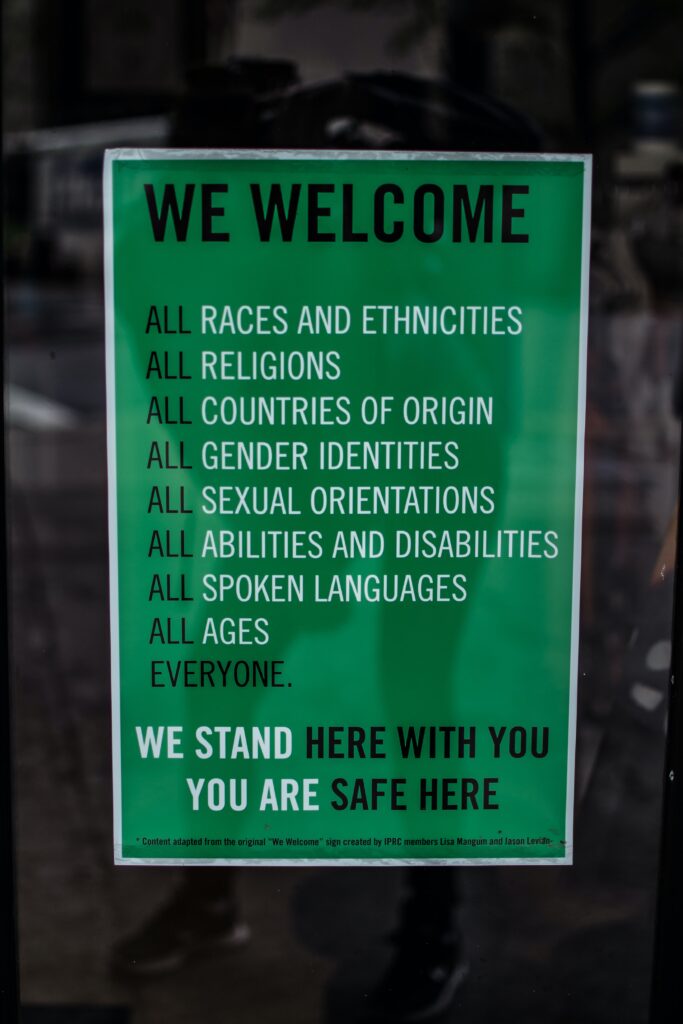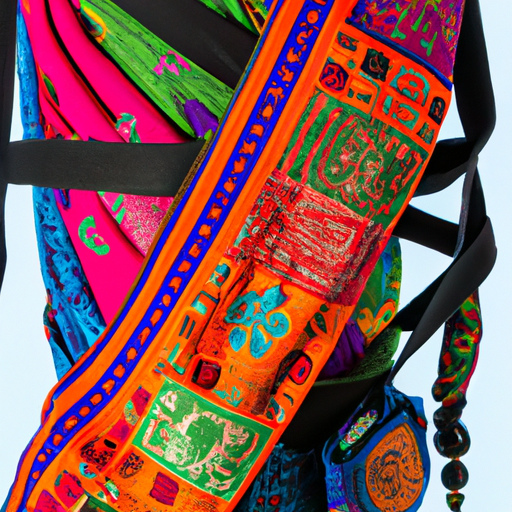In this article, you will learn all about the art of babywearing and how it embraces cultural ties. We will explore the history and benefits of babywearing, as well as various cultural practices and traditions related to carrying babies. You will also discover different types of baby carriers and accessories, along with tips for safe and comfortable babywearing. So, get ready to explore the fascinating world of babywearing and its special connections to different cultures.

Benefits of Babywearing
Babywearing, the practice of carrying your baby in a carrier or sling, has been an integral part of caregiving in many cultures for centuries. Not only does it provide a convenient and hands-free way to carry your little one, but it also offers a multitude of benefits for both the parent and the baby. In this article, we will explore the various advantages of babywearing, the different types of carriers available, its historical origins, and its significance in different cultures around the world.
Bonding between parent and baby
One of the most significant benefits of babywearing is the enhanced bonding experience it creates between the parent and the baby. When you carry your baby close to your body, you establish a strong emotional connection that promotes trust and security. The physical contact and the constant proximity create a sense of closeness, allowing you to communicate and bond with your little one effectively. Babywearing nurtures a deep sense of intimacy and attachment, fostering a strong parent-child relationship from the very beginning.
Promotes physical development
Another advantage of babywearing is its positive impact on the physical development of the baby. When you carry your baby in a sling or carrier, their body is positioned ergonomically, supporting their natural posture and spinal alignment. This helps to prevent any discomfort or strain on their developing skeletal system. Additionally, the gentle swaying motion that occurs while you walk or go about your daily activities stimulates the baby’s vestibular system, promoting balance and coordination.
Enhances cognitive development
Babywearing also plays a significant role in the cognitive development of the baby. Being close to the parent provides a rich sensory environment, exposing the baby to various stimuli such as the parent’s voice, facial expressions, and body movements. This constant exposure stimulates the baby’s senses and encourages their brain to make important connections and neural pathways. This enhanced cognitive stimulation can lead to improved language development, social skills, and overall cognitive abilities in the long run.
Reduces colic and reflux
Colic and reflux are common issues that many babies experience during their early months. Babywearing has been shown to alleviate these problems by keeping the baby in an upright position, which helps to prevent the regurgitation of stomach acid. The gentle pressure applied to the baby’s stomach while being carried can also provide relief from colic symptoms, such as excessive crying and fussiness. By reducing discomfort and promoting better digestion, babywearing can contribute to a happier and more content baby.
Supports breastfeeding
For breastfeeding parents, babywearing offers a convenient way to nurse their baby on the go. The close proximity and skin-to-skin contact facilitate breastfeeding and help to establish a successful nursing relationship. Babywearing allows the parent to respond quickly to the baby’s hunger cues, ensuring that the baby is fed promptly and comfortably. It also provides privacy and support while nursing in public, allowing the parent to breastfeed discreetly and confidently.
Different Types of Baby Carriers
There are several different types of baby carriers available on the market, each offering unique features and benefits. Here are some of the most commonly used types of carriers:
Ring slings
Ring slings consist of a long piece of fabric threaded through two rings. The ends of the fabric are adjusted and secured using the rings, creating a pouch for the baby. Ring slings are easy to use and provide a customizable fit for both the parent and the baby. They are suitable for newborns and older babies and can be worn on the front, hip, or back.
Wraparound carriers
Wraparound carriers are made from a long piece of woven fabric that is wrapped around the parent’s body to create a secure and comfortable pouch for the baby. They require a bit more practice to master the wrapping technique but offer excellent support and versatility. Wraparound carriers can be used from birth to toddlerhood and can be worn in various positions.
Soft-structured carriers
Soft-structured carriers, also known as buckle carriers, feature a structured body panel with padded straps that are fastened using buckles or snaps. They provide excellent support and are easy to put on and take off. Soft-structured carriers are suitable for babies of all ages and can be worn on the front, back, or hip.
Mei tais
Mei tais are a traditional Asian carrier that consists of a rectangular body panel and long straps that are tied around the parent’s body to secure the baby. Mei tais offer a customizable fit and are suitable for newborns and older babies. They can be worn in various positions and provide excellent support and comfort.
Pouch slings
Pouch slings are a simplified version of a ring sling. They are made from a loop of fabric that is worn over one shoulder and across the torso, creating a pouch for the baby. Pouch slings are quick and easy to use but offer less adjustability than ring slings. They are best suited for older babies and can be worn on the front or hip.

Historical Origins of Babywearing
The practice of babywearing has deep historical roots and can be traced back to ancient civilizations and indigenous cultures around the world. In many traditional societies, babywearing was a common practice that served as a practical solution for caregivers, allowing them to carry out their daily tasks while keeping their babies close and secure.
Ancient civilizations and indigenous cultures
In ancient civilizations such as Ancient Egypt, Maya, and Aztec, babywearing was an integral part of the culture and everyday life. Artifacts and historical depictions from these civilizations often feature women carrying their babies in slings or wraps, showcasing the significance of babywearing in their communities.
Babywearing in traditional clothing
In many traditional cultures, such as those found in Africa, Asia, and South America, babywearing was woven into the fabric of their traditional clothing. Women would wear garments specifically designed to carry their babies, utilizing various techniques and fabrics to ensure comfort and safety.
Cultural significance and rituals
In some cultures, babywearing carried deeper cultural significance beyond its practical benefits. It was seen as a way to strengthen the bond between the baby and the caregiver and to promote a sense of community and belonging. Babywearing rituals and ceremonies were often performed, symbolizing the baby’s integration into the larger social fabric.
Role of baby carriers in nomadic communities
In nomadic communities, baby carriers played a crucial role in enabling the movement and survival of entire tribes. Carrying babies allowed nomadic families to maintain their nomadic lifestyle while providing constant care and protection to their little ones. Baby carriers were meticulously crafted using locally available materials, reflecting the resourcefulness and ingenuity of these communities.
Babywearing Around the World
Babywearing practices vary across different cultures around the world. Here are some examples of babywearing traditions from various regions:
Japanese traditional babywearing
In Japan, traditional babywearing is known as “Onbuhimo.” Onbuhimos are a type of carrier that features a rectangular body panel and shoulder straps that are tied around the parent’s body. Onbuhimos are traditionally used by fathers and grandparents to carry babies on their backs, allowing the parent to maintain a close bond with the baby while leaving their hands free for other tasks.
African babywearing traditions
Africa has a rich history of babywearing, with various tribes and communities practicing different forms of babywearing. For example, the Himba people in Namibia use a unique carrier called an “ohure,” which consists of a leather sling that wraps around the baby’s back and attaches to the mother’s forehead using a strap. This allows the mother to carry the baby securely while maintaining an unobstructed view.
Indigenous babywearing practices in the Americas
Indigenous communities in North and South America have a long-standing tradition of babywearing. The Inuit people in the Arctic region, for instance, use a traditional carrier known as an “amauti.” The amauti is a parka-like garment with a built-in hood that can be used to carry the baby on the back. This carrier provides warmth and protection in the harsh Arctic climate while allowing the parent to care for the baby.
European babywearing traditions
Even in Europe, babywearing has been a part of cultural traditions. In some regions, such as Corsica and Sardinia, woven wraps known as “fazzoletti” have been used for generations to carry babies. These wraps are often made from intricate handwoven fabrics and have become symbols of cultural identity and heritage.

Modern Babywearing Trends
In recent years, babywearing has seen a resurgence in popularity, especially in urban environments. As more parents embrace the benefits of babywearing, new trends and innovations have emerged in the world of baby carriers.
Babywearing in urban environments
In bustling cities, babywearing offers a practical solution for navigating crowded streets, public transportation, and busy schedules. Urban parents often turn to baby carriers that are lightweight, easy to use, and compact. They value the convenience and versatility that babywearing provides, allowing them to keep their little ones close while going about their daily activities.
Babywearing in the Western world
In the Western world, the popularity of babywearing has grown steadily in recent years. With the rise of attachment parenting and a focus on nurturing the parent-child bond, more parents are turning to baby carriers as a way to provide constant physical contact and emotional support to their babies.
Celebrity endorsements and influence
The endorsement of babywearing by celebrities has also helped to popularize the practice. Numerous celebrities have been photographed wearing their babies in carriers, bringing attention to the benefits of babywearing and making it a fashionable trend. The visibility of these public figures has contributed to the normalization of babywearing in popular culture.
Integration of babywearing in fashion
With the increasing popularity of babywearing, fashion designers have started incorporating baby carriers into their collections. Baby carriers are now available in a wide range of stylish designs, fabrics, and patterns, allowing parents to express their personal style while carrying their babies. This integration of babywearing in fashion has made it more accessible and appealing to a broader audience.
Tips for Safe and Comfortable Babywearing
While babywearing is generally safe and beneficial when done correctly, it is essential to follow some guidelines to ensure the safety and comfort of both the parent and the baby. Here are some tips for safe and comfortable babywearing:
Choosing the right carrier
Select a carrier that suits your needs and preferences while considering the age and developmental stage of your baby. Different carriers offer various levels of support and adjustability. It is crucial to find a carrier that distributes the baby’s weight evenly and provides proper head and neck support.
Proper positioning and weight distribution
Ensure that your baby is positioned in an ergonomic and natural M-shaped seated position. Their knees should be higher than their bottom to promote healthy hip development. The baby’s weight should be evenly distributed across your body, and their airways should remain open and unobstructed.
Monitoring baby’s comfort and physical cues
Pay attention to your baby’s cues for comfort and adjust the carrier as needed. Check for signs of discomfort, such as red marks or indentations on the baby’s skin, excessive fussiness, or difficulty breathing. Regularly inspect the carrier for signs of wear and tear to ensure its safety and functionality.
Be mindful of weather conditions
Consider the weather conditions when babywearing. Dress yourself and your baby appropriately to ensure comfort and safety. Use breathable fabrics in hot weather and layer appropriately for colder temperatures. Protect your baby from direct sunlight and ensure they are adequately hydrated when outdoors.
Practice proper babywearing techniques
Take the time to learn and practice proper babywearing techniques. Attend local babywearing groups or seek guidance from a certified babywearing educator to learn the correct way to tie and adjust your carrier. Following proper techniques will ensure the safety, comfort, and enjoyment of both you and your baby.

Babywearing and Parenting Styles
Babywearing often goes hand in hand with various parenting styles that emphasize close physical contact and responsiveness to the baby’s needs. Here are some parenting styles commonly associated with babywearing:
Attachment parenting
Attachment parenting is a parenting philosophy that advocates for building strong emotional bonds between the parent and the child. It promotes practices such as babywearing, breastfeeding on demand, co-sleeping, and responsive caregiving. Babywearing plays a significant role in attachment parenting, as it allows for constant physical contact and nurtures the bond between the parent and the baby.
Gentle parenting
Gentle parenting focuses on promoting a nurturing and respectful relationship between the parent and the child. It emphasizes understanding and meeting the baby’s needs while setting age-appropriate boundaries. Babywearing aligns well with gentle parenting principles by providing a safe and secure environment for the baby, fostering trust and emotional well-being.
Positive discipline
Positive discipline is an approach to parenting that seeks to guide and teach children through respectful communication and problem-solving techniques. Babywearing can provide a practical solution for parents to address their child’s needs promptly and effectively. By carrying their baby close, parents can respond to their cues and address any issues in a timely and gentle manner.
Co-sleeping and babywearing
Co-sleeping, the practice of sharing a sleeping space with the baby, often goes hand in hand with babywearing. Both practices emphasize the importance of constant physical proximity and a nurturing environment. Babywearing allows parents to keep their baby close during the day while co-sleeping provides the same closeness during nighttime.
Babywearing and Cultural Identity
Babywearing has always been deeply intertwined with cultural identity throughout history. It is a practice that reflects the unique traditions, values, and customs of different communities worldwide. Babywearing is not only a practical childcare method but also a meaningful expression of cultural heritage and familial ties.
Preservation of cultural traditions
In many communities, babywearing serves as a way to preserve and pass on cultural traditions from one generation to the next. Families proudly continue the practice of babywearing as a way to honor their ancestors and maintain a connection to their heritage. Through babywearing, cultural traditions are woven into the daily fabric of family life.
Representation of cultural diversity
Babywearing also highlights the rich diversity of cultures around the world. It exemplifies the unique ways in which different communities care for and nurture their babies. The practice serves as a universal language that transcends borders, showcasing the universal value of constant physical contact and emotional support.
Cultural appropriation and respectful babywearing
While babywearing offers an opportunity to celebrate cultural diversity, it is essential to approach it with respect and cultural sensitivity. Cultural appropriation occurs when elements of one culture are adopted without proper understanding or appreciation. It is crucial to educate oneself about the cultural significance and history of the babywearing practices to avoid appropriating a cultural symbol or exploiting its meaning.

Benefits of Babywearing for Parents
While the benefits of babywearing for babies are well-documented, it also offers numerous advantages for parents. Here are some benefits of babywearing for parents:
Hands-free convenience
One of the practical benefits of babywearing is the ability to have your hands free while still offering your baby the closeness and attention they need. It allows you to go about your daily activities without being restricted by pushing a stroller or carrying the baby in your arms. Babywearing provides a comfortable and convenient way to keep your baby close while attending to other tasks.
Increased bonding and attachment
Babywearing promotes a strong bond between the parent and the baby. The constant physical contact and proximity enable the parent to respond quickly to the baby’s needs and cues. This constant presence and responsiveness enhance the parent-child relationship, fostering a sense of security and trust between the two.
Ease of breastfeeding
For breastfeeding parents, babywearing can make nursing on the go much more manageable. The ease of breastfeeding while wearing a carrier allows the parent to feed the baby discreetly and comfortably, regardless of the location. Babywearing supports the parent’s ability to breastfeed on demand and helps establish a successful nursing relationship.
Facilitates multitasking
Parenting often requires multitasking, and babywearing allows parents to juggle various tasks while keeping their baby close. Whether it’s preparing a meal, doing household chores, or running errands, babywearing provides the flexibility to engage in daily activities without compromising the baby’s needs.
Decreased postpartum depression and anxiety
The close physical contact and emotional support provided by babywearing can help reduce the risk of postpartum depression and anxiety in parents. The constant presence of the baby and the release of oxytocin, also known as the “love hormone,” during babywearing can promote feelings of well-being and connection, alleviating symptoms of postpartum mood disorders.
Conclusion
Babywearing, an art that spans across time and cultures, offers numerous benefits to both the parent and the baby. It enhances the bond between parent and child, promotes physical and cognitive development, and provides practical solutions for everyday parenting challenges. As we embrace the art of babywearing, we also celebrate cultural diversity and honor the traditions that have shaped the practice of carrying our babies close. By embracing babywearing as more than just a parenting trend, we can create a world that values the importance of bonding, nurturing, and cherishing our little ones.





